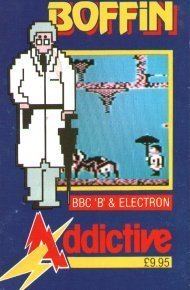8 /10 1 Votes8
Developer(s) Paul Julian O'Malley Initial release date 1985 Genre Platform game | 4/5 Emuparadise Release date(s) 1985 Mode Single-player video game | |||||||||||||||||||||||||||||||||
 | ||||||||||||||||||||||||||||||||||
Similar Stryker's Run, Frak!, Citadel, Deathstar, Imogen | ||||||||||||||||||||||||||||||||||
Boffin is a platform game released in 1985 by Addictive Games for the Acorn Electron and BBC Micro. It was written by 17-year-old Paul Julian O'Malley, who at the time was a resident of Romsey, Hampshire, UK. There are two versions of the game that were released together.
Contents
Gameplay
The player must guide the Boffin through a series of caverns by moving him around the platforms and obstacles on the levels. The Boffin can only jump short distances, but he can fall from any height by opening his umbrella to slow his descent to a safe speed. Each level ends when the player touches an owl which is usually located at the bottom of the screen. The 'lucky' owl can only be touched without resulting in death if all of the 'unlucky' upside-down horseshoes have been destroyed.
Boffin plays in a similar way to many platform games of the era (such as Manic Miner) but is notable for a number of reasons. The 'umbrella' mechanic was unique at the time, and means that many levels progress from the top of the screen to the bottom, which was unusual as most platformers since Donkey Kong required the player to travel from bottom to top. Also the use of Mode 5 graphics on the 'version 2' version of the game meant that the graphics were much larger and more colourful than many contemporary games (although the trade-off was that it was very blocky).
The game features giant menacing tarantulas, which are very detailed and highly animated for the era. The tarantulas cannot be killed, and only advance across the screen in one direction (right to left). They remain motionless until the Boffin is in their line of sight, then rapidly run forwards.
Release and versions
The game was released in 1985 on one cassette for both the BBC Micro and Acorn Electron. The cassette contains two different versions of the game. The first version on the tape (confusingly referred to as 'version 2' and sometimes known as Boffin 2) features twenty five caverns and is playable on both machines. The second version on the tape ('version 1') is for the BBC Micro only, featuring twenty different caverns. The versions are so different as to almost be different games; 'version 2' is in the very blocky graphical Mode 5 (possibly Mode 2), and 'version 1' is in the much more defined (but less colourful) Mode 1. The graphics and puzzles differ considerably between the two versions, although the underlying theme is identical.
Critical reception
Jon Revis of Electron User particularly praised the tarantula: "He is drawn in superb detail and the characteristic jerky movement of such arachnids - not a programming defect - is impeccable". Although at the time the magazine did not award scores, the review concludes that despite there being many similar games on the market, "...Boffin has sufficient originality to succeed against all the competition".
Influence
Since the game only appeared on the BBC and Electron and never surfaced on more popular machines such as the ZX Spectrum, Commodore 64 or Amstrad CPC it remains fairly obscure and its innovations were never developed further.
Superior Software later released a similar game Elixir, in which a scientist is shrunk to miniature size and must navigate around his laboratory to collect items to restore his size. The similarities are thought to be coincidental.
